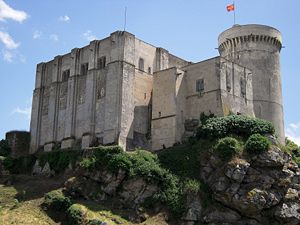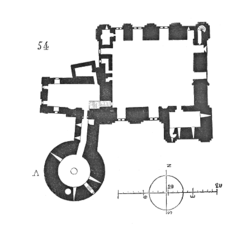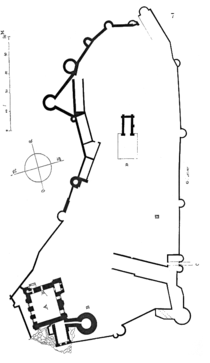- Château de Falaise
-
Château de Falaise
Falaise CastleFalaise, Basse-Normandie, France 
Photograph of the keepsCoordinates 48°53′37″N 0°12′14″E / 48.8936°N 0.2039°ECoordinates: 48°53′37″N 0°12′14″E / 48.8936°N 0.2039°E Construction
materialsLimestone Current
conditionRenovated Current
ownerCity of Falaise Controlled by Dukes of Normandy 
The Château de Falaise is a castle located in the south of the commune of Falaise ("cliff" in French) in the Calvados département of Normandy, France.
The town of Falaise was the birthplace of William the Conqueror, first of the Norman kings of England. The castle (12th–13th century), which overlooks the town from a high crag, was formerly the seat of the Dukes of Normandy.
The construction was started on the site of an earlier castle in 1123 by Henry I of England, with the "large keep" (grand donjon). Later was added the "small keep" (petit donjon).
The tower built in the first quarter of the 12th century contained a hall, chapel, and a room for the lord, but no small rooms for a complicated household arrangement; in this way, it was similar to towers at Corfe, Norwich, and Portchester, all in England.[1]
In about 1207, after having conquered Normandy, Philip II Augustus ordered the building of a new cylindrical keep. It was later named the Talbot Tower (Tour Talbot) after the English commander responsible for its repair during the Hundred Years' War.[2] It is a tall round tower, similar design to the towers built at Gisors and the medieval Louvre.
It changed of hands several times during the Hundred Years' War. The castle was deserted during the 17th century. A programme of restoration was carried out between 1870 and 1874. The castle suffered due to bombardment during World War II in the battle for the Falaise pocket in 1944, but the three keeps were unscathed.

 Overview of the enclosure of the castle, drawn by Viollet-le-Duc (left image), and detail of a window, from the Dictionnaire of Eugène Viollet-le-Duc (right image)
Overview of the enclosure of the castle, drawn by Viollet-le-Duc (left image), and detail of a window, from the Dictionnaire of Eugène Viollet-le-Duc (right image)See also
References
- Notes
- Bibliography
- Bradbury, Jim (2004), Companion to Medieval Warfare, Routledge, ISBN 0415413958, http://books.google.com/?id=j6y0E6YO-oEC&pg=PA301&lpg=PA301&dq=Falaise+Castle+restoration
- McNeill, Tom (1992), English Heritage Book of Castles, London: B. T. Batsford and English Heritage, ISBN 0-7134-7025-9
External links
- Official website : more informations, virtual visit (English)
- Ministry of Culture database entries: (1) and (2) (French)
- Ministry of Culture picture collections:(1) and (2)
- This article incorporates information from this version of the equivalent article on the French Wikipedia.
Categories:- Châteaux in France
- Buildings and structures in Calvados
- Official historical monuments of France
Wikimedia Foundation. 2010.


